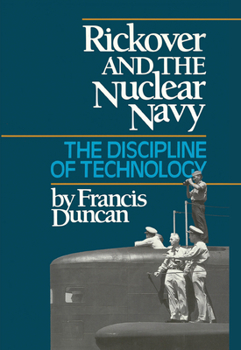Rickover and the Nuclear Navy: The Discipline of Technology
Select Format
Select Condition 
Book Overview
No book will ever come closer than this to providing an inside overview of Admiral Hyman G. Rickover's nuclear propulsion program. The author, an Atomic Energy Commission (AEC) historian assigned to the admiral's office, spent years observing the project and its controversial leader in action, and the insights he provides here reflect both his familiarity with the subject and his ability to remain an objective observer. From 1974 to the day Rickover retired in 1982, Francis Duncan had free access to files, documents, and personnel at every level of involvement--a rare, never-to-be-repeated opportunity that most historians dream of but few get. And, as this book clearly shows, he took full advantage of the situation to gain a unique understanding of exactly how the program operated. The result is a thorough, balanced record of what may well be the U.S. Navy's and the nation's most important and far-reaching project of the twentieth century. Knowing that facts and figures alone don't tell the entire story, Duncan talked to scores of people who dealt with day-to-day operations, watched men in prototype training and then accompanied them to sea, visited civilian and naval installations, and had close contact with Rickover himself. He also interviewed former U.S. presidents, secretaries of the navy, chiefs of naval operations, AEC chairmen, and legislative leaders who kept tabs on the projects but were removed from daily activities. Never once, the author says, did the admiral attempt to interfere with his research, nor did Rickover read the manuscript. While the focus here is on the nuclear program, not the man, this book does provide fascinating insights into Rickover's personality and his efforts to maintain standards of excellence that would assure the program's safety and its ultimate success. Using one of the admiral's favorite terms, "the discipline of technology," to demonstrate the method of technological application advocated by Rickover, Duncan effectively balances technical detail with astute analysis and even drama. Filled with information not found elsewhere, his study is a valuable chronicle of the development of submarine propulsion reactors, the loss of the Thresher, the struggle over the application of nuclear propulsion to surface fleet, and the use of the Shippingport Atomic Power Plant to illustrate the feasibility of a light-water breeder reactor.
Format:Hardcover
Language:English
ISBN:0870212362
ISBN13:9780870212369
Release Date:December 1989
Publisher:Naval Institute Press
Length:424 Pages
Weight:1.78 lbs.
Dimensions:1.3" x 6.2" x 9.1"
Related Subjects
HistoryCustomer Reviews
1 rating
A view into the founding of Nuclear Safety Culture
Published by Thriftbooks.com User , 23 years ago
I have recently been doing some research on ethnographics, trying to better understand how the operating culture of nuclear power plants evolved. I was directed toward biographies of Admiral H.G. Rickover, and I found Duncan's work to be one of the most enjoyable readings on Rickover. Duncan gives an inside view to the Admiral and the history that led to the success of the Nuclear Navy through a historical account. The author's relationship with the Admiral, which was probably closer than many other biographers, shows Rickover a hard-driven centrist leader who stressed technical competence and sought excellence and integrity, as well as a respect and dedication for the high-risk technology. My only criticism would be that other biographies of Rickover dealve more into the Admiral's idiosincracies and somewhat odd expectations -- traits that leave the reader wondering if Rickover was crazy or a genius. I look forward to reading Duncan's new book "Rickover: A Struggle for Excellence" when it is released November 2001.





